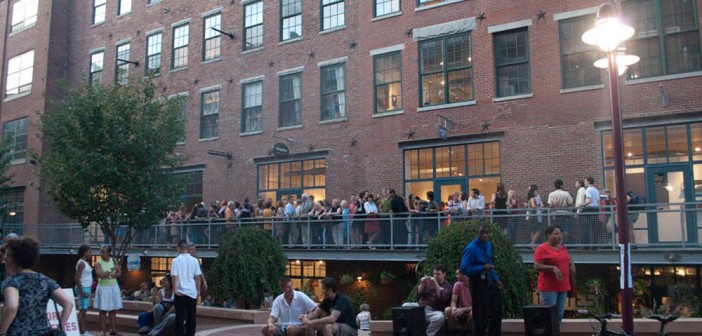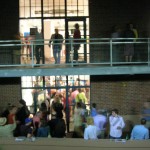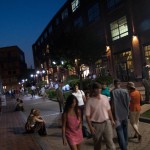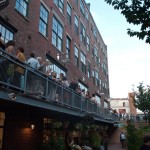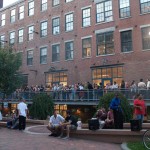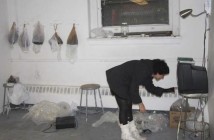I remember walking past the newly renovated condos that constrict the Pine Street Inn, entering the aisles of dimly lit galleries stacked upon themselves like a mini-mall in Carmel. I moved through the plaza between the galleries, peering into the windows to see displays of pottery platter-ware, paintings of sailboats, (and in the more contemporary galleries) grayish-black blurs on hazy white walls. It was summer, the sun had yet to fully set. And the event had already ended. I walked past the first pub within reach and I heard the jabberings from one of the dispersed. "...second-tier city.." he said.
If you haven’t attended (as I hadn’t often until several months ago), Boston’s Boston’s SOWA First Fridays is an "integral part of the SOWA Artists Guild mission.... "[the guild]strives to make its art and its artists accessible to all, working together to inspire people to appreciate art on a whole new level." What is not made clear without attending is that FF houses a grouping of more than half of the relevant galleries in Boston, the majority of which sit underneath a few floors of small studios.
This article focuses on the space within the central galleries and courtyard that has been advertised as an open forum with a specific artists’ community, a date night for the young and artsy, or, by the ICA, a good excuse for an appletini. What should be clear is that within the ground-floor you will find a wide range of interests and approaches, functioning autonomously of each other. In my latest visit I watched a group of awestruck children in a room filled with large balls of wound fibers. I was moved very much by the experience that the children were having; with the encouragement they seemed to be receiving. On the other end of the courtyard there was a barrel full of free beer that was also enticing a group of youngsters to collect. In between is wine-and-cheese and a circuit of galleries showing work by seasoned and emerging artists. I admit I’m not going to delve too much into the weight of those terms, or into the politics of the gallery system - I am an observer, and won’t pretend to comment far beyond the scope of my essay.
It seems obvious, though, that one of the hopes involved in an event like First Friday is an encounter with something new and extraordinary; work that transports an audience; opportunities that transport the artist. I think of Raul Gonzalez, who has made a good life for himself through the opportunities found in Boston and her galleries. In conversation with Raul, or the blossoming Alexa Guariglia, you hear gratitude to the city of Boston - and rightly so. More difficult to cite is an experience that I hope is relatable: that lurking, geographical self-consciousness of our proximity and distance to New York. That self-consciousness, which seems to undercut the general actions and comportment of Bostonians. I say this is difficult to cite because it is subtle and ever-present. Even talking about how great the Boston scene is somehow maintains the rhetoric of defending it against an abstract monster, whispering about bigger places where the art market involves serious collectors and millions of dollars from around the globe. Boston lacks general standing in the international art market, and this is highlighted by the way our most wealthy citizens buy art: by going elsewhere. As I understand it, few people travel to Boston to buy, even if they live in Cambridge. Certainly, this changes the scope of FF - even work that eschews this (admittedly old-school) commercial model, is somehow denied the ambient glitz that throws purposeful non-participation into high relief. We are not rural or naive enough to be pure outsiders; not cosmopolitan enough to be genuinely involved in the market - even in reaction to it. What’s a girl to do?
In a way, the solution isn’t difficult. The internet exists; we have ‘gone global’. Maggie Cavallo got it right when she wrote on her wordpress last August, "[i]t … goes without saying that we are living in the most global economy to date; I am all about buying/selling local from tomatoes to sculptures, but the fact is artists are not selling their work to the city where they reside alone." Nach. But what makes me uneasy about this phenomenon is that it corresponds with the politics of outsourcing; I even fall back on a kind of corporate diction when I describe it. Our relationship with galleries gets somehow associated with business and colonialism. The best galleries and venues feel a need to strike a balance between local acts and global acts, which means with a de-emphasised relationship with the local, or a relationship that casts local artists as relevant only as an affirmative-action-type novelty. The presumption is always that the best local acts will become or are already global. Why not? Everybody wants to move up, right? But this does something funny to our little society, to our community. I think it is observable. in fact, I think thats what I’ve observed.
I’ve gone to FF for the same reason I go to a venue like TT the Bear’s: to see local artists, talk with them, and see what it’s like. There’s striking similarity between the venues: both are places for artists with "day jobs", and both venues have a central informed audience. What is more curious, but not surprising, is that the informed audience seems to be there for another reason than the one advertised - there’s an attraction listed on the Facebook event, sure, but there’s another ring to that circus. What is center stage for many might not be the art object itself, but the objectives of the individuals and their tribes.
Let me triangulate on this with an anecdote. Recently, I went to see some friends playing a show at TT’s. They were surrounded by a psychedelic Venn diagram of friends, ex-classmates, fellow musicians, fans, scenesters; all familiar; all accounted for. In a way It is hard to see friends perform. Had I shot a video of of their set, it would have shown the band playing as the background. In the foreground fellow musicians and fans talking incessantly over the set, "They got that same Nord Lead keyboard at Sony, I saw it during a Passion Pit recording," dude said to a girl with an X on her hand. The two paused for a moment to clap and holler before returning to their conversation, then predictably walked up to their acquaintance later to remark how moved they had been. These scenarios are not difficult to imagine - indeed it’s never necessary to imagine them, or really to describe them at all. One comes to expect that this is the way things work.
The nights I went to First Friday, I went to admire new work and the general splendor - but I admit that I carried a morbid curiosity about the dynamic I’ve just described. I wasn’t wrong. You can be a "goer" at First Friday and not really "go" for the art. You can be a goer for the limited wine and cheese, a goer for the pretenses of yourself and your involvement in the scene, and of course you go to see friends and look at acquaintances. The issue isn’t decorum (who gives two tugs about that) but a lack of care, and we should care. First Friday, whether we like it or not, is the primary way people engage with art and artists in our city. Whether or not we find the level of art or audience "lacking" is unimportant. Whether or not we plan to sell globally is unimportant. If you drinking an appletini next to a wet shelter to meet your next sexual conquest and maybe make some headway on your current projects, it has consequences: a hollow vodka buzz and a networking hangover, for example. What we do with what we have is in someways more important than what we do, for we define our community and its level of discourse.
It isn’t the artist’s job to fix politics, the power structure of academia, the general racism, real estate problems, or our city's bedtime. We can at least set precedents within our own particular spheres. At the BR&S Forum at the List Center a few weeks ago, João Ribas made a comment that Boston needs to learn how to talk to the global community; how to address and engage it. Horizontal structures can replace our pyramid system. If you topple the architecture, it means very little to be "second tier". Then, we are left with art, and the astonishing resonance it can have with the human spirit. The most difficult action, for many of us, is shifting back from the complex social constructs that we have created to return to what is most central: dynamic art. There is a feeling that romantic notions such as these are the babblings of the naive, however it's dialectical opponent is an embrace of all life interactions as a grimy hustle, which eventually attempts to cast art out for something more practical.
- A view of SOWA First Fridays from 2005. Photo courtesy of James Manning.
- Later in the night, SOWA First Fridays in 2007. Photo courtesy of James Manning.
- Another view of SOWA First Fridays from 2008. Photo courtesy of James Manning.
- A view of SOWA First Fridays from 2008. Photo courtesy of James Manning.

